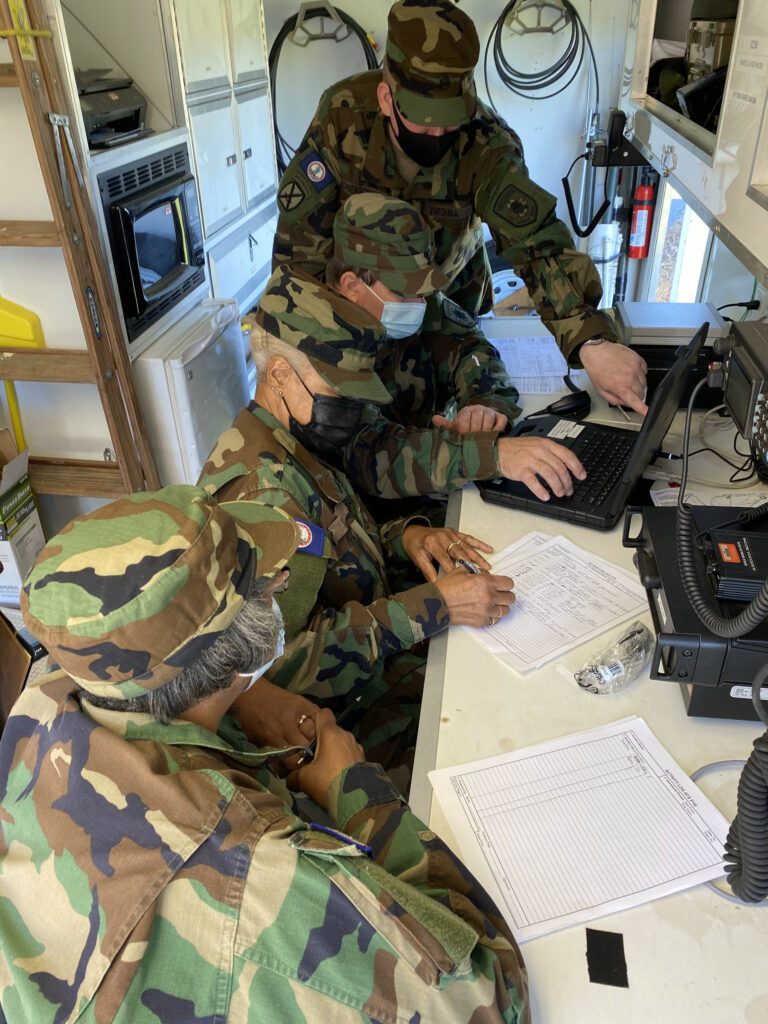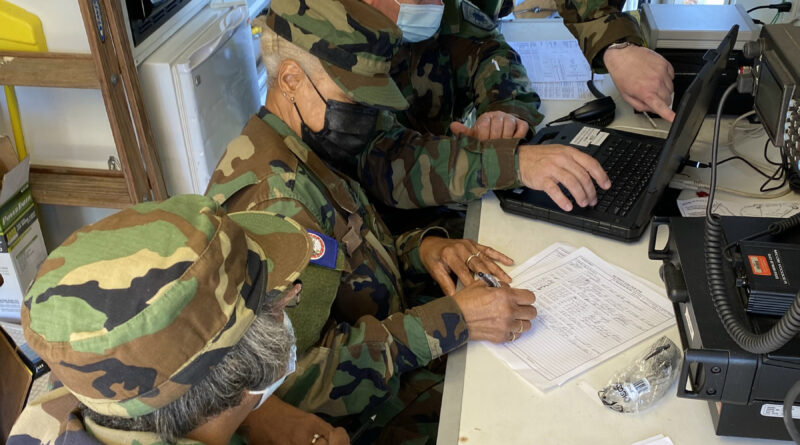VDF conducts statewide response exercise

LYNCHBURG, Va. — Members of the Virginia Defense Force conducted the Highland Guardian field training exercise Nov. 7, 2020, at multiple locations across Virginia to test their regional liaison, incident management assistance and interoperable communications support capabilities. The exercise simulated a severe weather situation causing traditional cellular and internet services to be severely degraded, and it also integrated amateur radio organizations based in Lynchburg and Northern Virginia.
“After visiting VDF training in Lynchburg and seeing first hand what they can do and how well they do it, I am more confident than ever we can count on them to be there when we need them,” said Maj. Gen. Timothy P. Williams, the Adjutant General of Virginia. “The VDF continues to be a vital part of the Virginia National Guard team and provide us with important additional capabilities, and I am so impressed by the hard work of the dedicated volunteers who so willingly give their time, energy and abilities to be able to assist their fellow Virginians.”
As part of the statewide communications exercise, VDF personnel located in Lynchburg, Richmond, Virginia Beach, Winchester and Cedar Bluff were able to communicate by high frequency radio and share exercise message traffic. The VDF’s Communication Battalion, Support Operations Group deployed their mobile communication platforms to three locations, and the companies of the 1st Regiment provided high frequency radio and incident management assistance teams at their home stations at Virginia National Guard readiness centers. All total, more than 400 messages were sent and received use voice and data communications.
“I am extremely happy with the how well our personnel performed during the Highland Guardian exercise,” said Brig. Gen. (Va.) Justin P. Carlitti, Sr., commander of the VDF. “I have been with the VDF for eleven years, and we have now reached a level of proficiency we have not seen in the organization since I joined. We showed our system works, our people trained, and we are building on these successes. This is where we should be, and I am very proud of the organization.”
Carlitti said he was also impressed with VDF junior leaders demonstrating initiative during challenging situations and taking charge to move things forward. He also acknowledged the exercise sufficiently stressed both personnel and the systems they used, very much simulating real-world situations and the different paths to be followed to find solutions.
He also commended Lt. Col. (Va.) Phil Smith for his work as the exercise director and Lt. Col. (Va.) Mark Brinkley for designing the exercise scenario.
As part of the statewide communications exercise, VDF personnel located in Lynchburg, Richmond, Virginia Beach, Winchester and Cedar Bluff were able to communicate by high frequency radio and share exercise message traffic. The VDF’s Communication Battalion, Support Operations Group deployed their mobile communication platforms to three locations, and the companies of the 1st Regiment provided high frequency radio and incident management assistance teams at their home stations at Virginia National Guard readiness centers. All total, more than 400 messages were sent and received use voice and data communications.
The exercise also integrated VDF personnel who will operate as liaison officers in Virginia Department of Emergency Management regional response centers to facilitate communication between localities and the Virginia National Guard.
VDF leaders captured a number of key lessons learned in their after action review.
While integrating the amateur radio organizations was an important step in continuing to understand their capabilities and building partnerships, leaders acknowledged it is important for all stations operating on the radio network to use common terminology and work to improve message brevity.
Most equipment and web-based systems were fully functional during the exercise, and this was due to the amount of time spent each month testing and training to make sure they are ready to go when needed. Systems that did not work well were identified for corrective action to get them operational.
During the after action review, Carlitti shared his ongoing conversations with multiple amateur radio organizations who expressed their desire to continue training with the VDF, and additional exercises are being planned for 2021.
The VDF MCP is a 7 1/2 feet by 16 feet trailer equipped with multiple radio systems for voice and data communications, and it also features a map board and work space so it can function as a mobile command post. Using an MCP, members of the VDF are able to communicate across a variety of radio spectrums with emergency response and public safety organizations as well as amateur radio operators. In the event of severe weather like hurricanes or heavy snow where traditional communication systems could become disrupted, the VDF MCPs would provide a vital communications capability for the VNG as it conducts operations to assist with keeping citizens of the commonwealth safe.
VDF personnel providing incident management assistance employ Tactical Communication Packages used for internet connectivity to operate web-based communications like WebEOC used to track missions during emergency response operations.
The VDF is authorized by Title 44 of the Code of the Virginia as the all-volunteer reserve of the Virginia National Guard, and it serves as a force multiplier integrated into all Guard domestic operations. The VDF reports to the Adjutant General of Virginia as part of the Virginia Department of Military Affairs along with the Virginia Army National Guard and Virginia Air National Guard. Members of the VDF volunteer their time for training and are only paid when called to duty by an authorization from the Governor of Virginia.

